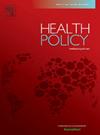Medicare austerity reforms and patient out-of-pocket costs: The experience from Australian cancer patients
IF 3.6
3区 医学
Q1 HEALTH CARE SCIENCES & SERVICES
引用次数: 0
Abstract
In this paper, we examine trends in provider fees charged, government expenditure on private out-of-hospital medical services, and out of pocket costs following policy changes intended to reduce government expenditure. We examine the experience of a high-need patient group: people diagnosed with cancer. The Australian system for these services is predominantly publicly funded under fee for service; with no government control on the fees charged by providers. We calculate out of pocket costs for patients in the 12 months following a cancer diagnosis and find a large variation in these costs according to the type of treatment received as well as the place of residence and presence of additional government protection. We find that volumes of services, provider fees, and out of pocket costs rose over time. These findings are especially important for a high-need patient group as out of pocket costs are considered a barrier to access to healthcare. Governments may respond to the long-term fiscal challenges by attempting to constrain benefits it pays; our results demonstrate that careful consideration of the full impact of such policies is needed.
医疗保险紧缩改革和患者自付费用:来自澳大利亚癌症患者的经验
在本文中,我们研究了在旨在减少政府支出的政策变化之后,提供者收费、政府在私人院外医疗服务上的支出和自付费用的趋势。我们研究了高需求患者群体的经历:被诊断为癌症的人。澳大利亚的这些服务系统主要由公费支付;政府对供应商收取的费用没有控制。我们计算了患者在癌症诊断后12个月内的自付费用,发现这些费用根据所接受的治疗类型、居住地和是否存在额外的政府保护而有很大差异。我们发现,随着时间的推移,服务量、供应商费用和自付成本都在上升。这些发现对于高需求患者群体尤其重要,因为自付费用被认为是获得医疗保健的障碍。为了应对长期财政挑战,政府可能会试图限制其支付的福利;我们的研究结果表明,需要仔细考虑这些政策的全面影响。
本文章由计算机程序翻译,如有差异,请以英文原文为准。
求助全文
约1分钟内获得全文
求助全文
来源期刊

Health Policy
医学-卫生保健
CiteScore
6.40
自引率
6.10%
发文量
157
审稿时长
3-8 weeks
期刊介绍:
Health Policy is intended to be a vehicle for the exploration and discussion of health policy and health system issues and is aimed in particular at enhancing communication between health policy and system researchers, legislators, decision-makers and professionals concerned with developing, implementing, and analysing health policy, health systems and health care reforms, primarily in high-income countries outside the U.S.A.
 求助内容:
求助内容: 应助结果提醒方式:
应助结果提醒方式:


